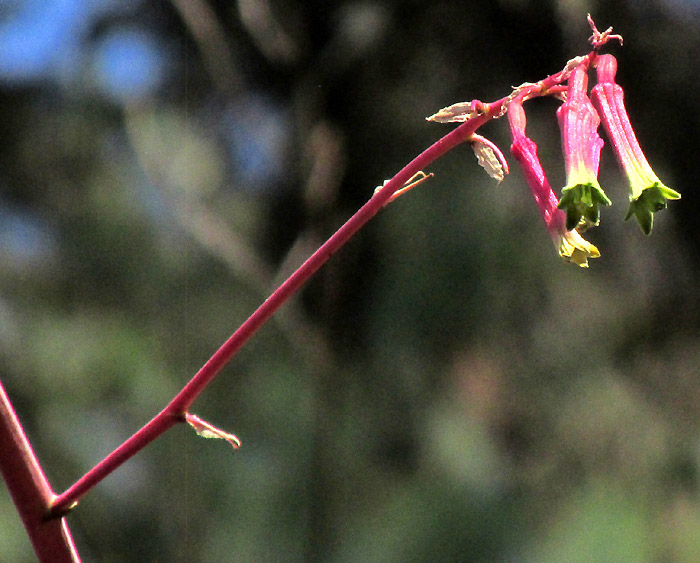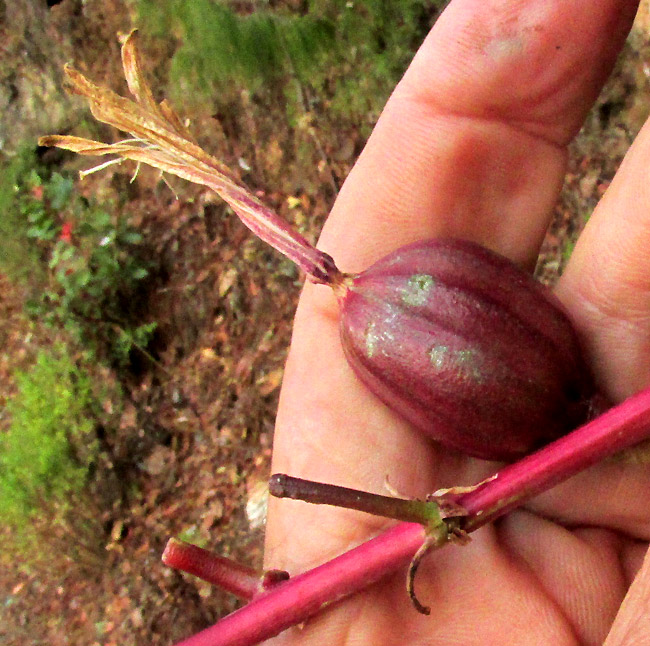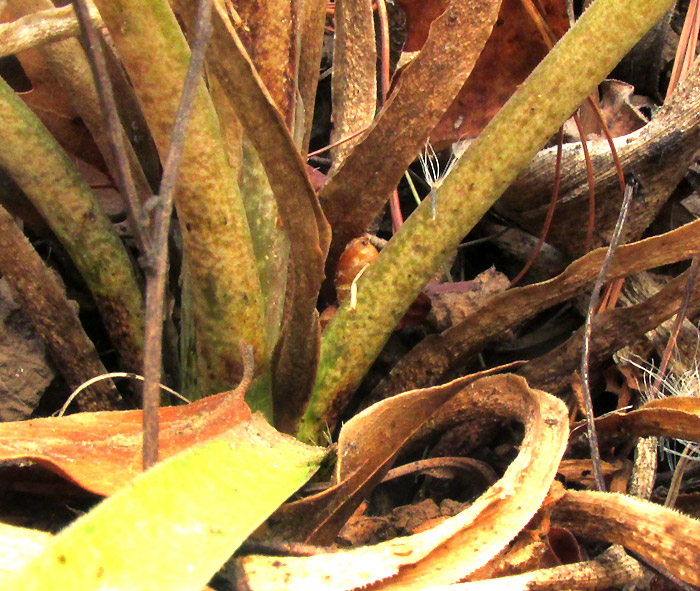Excerpts from Jim Conrad's
Naturalist Newsletter
Entry dated April 19, 2024, from notes taken about 1.5km northeast of Puerto de los Velazquez, Municipality of Pinal de Amoles; N21.134°, W99.667°, elevation ~2760 meters (~9050 feet); oak/pine forest on limestone bedrock; in the Eastern Sierra Madre Mountains in east-central Querétaro state, MÉXICO
BESCHORNERIA cf. TUBIFLORA

Atop an old roadcut through limestone bedrock, the above colony of agave-like plants grew in a semi-shaded spot. Probably the slope was treeless because someone had cut the trees, then abandoned the area, or else the soil was too thin for trees; oak-pine forest grew all around.

The pink inflorescence looked like it was over two meters tall (7ft). Flowers grew sparsely on panicle-type inflorescence branches -- a detail helpful in identifying the genus.

Maybe a hundred steps up the road, another little colony occupying a similar habitat was fruiting, its weighted-down flowering stalk leaning toward the road, so its maturing, capsular-type fruits could be reached.

With the withered corolla and stamens still atop the enlarging fruit, the ovary was a classic inferior one. I read that pods remain on the stalks of species in this genus for several months, eventually splitting to release black, shiny seeds.

The flexible, not-so-succulent leaves averaged about 1cm wide (0.4inch), with margins bearing tiny, broad-based, forward-curved spines.

Leaf bases were somewhat mottled and it was hard to say whether the splotches resulted from the ongoing D4 Drought -- the droughtiest drought recognized by the North American Drought Monitor -- or if it was normal.
Prior to 2009, such plants as these were assigned to the Agave Family, the Agavaceae, but currently they occupy the agave subfamily of the Asparagus Family, the Asparagaceae. In our part of upland central Mexico, if you have a member of the agave subfamily whose flowers produce inferior ovaries arrayed in panicle-type inflorescences, the leaves are not rigid and fleshy like an agave's, and the flowers are reddish to yellow-green, not white to cream, then you have the genus Beschorneria, whose species in English usually are just called beschornerias.
Currently, Kew's Plants of the World Online database recognizes eight Beschorneria species; one occurs in Texas and the rest only in Mexico. Of the seven Mexican species, two are so poorly documented that it's not known where in Mexico they were discovered. I find no treatment distinguishing the species, but the study by Fabiola Magallán Hernández and Luis Hernández Sandoval, published in 2000 and entitled "La Familia Agavaceae en el Estado de Querétaro, México," reports only one Beschorneria species in Querétaro state, and that's Beschorneria rigida. Features of Beschorneria rigida seen in photographs on the Internet mostly matched those shown by plants. Moreover, the authors found their Beschorneria rigida in the same highland municipality of Pinal de Amoles where our plants turn up.
Since this species is seldom documented in the wild, at the Agaveville.Org website where some savvy succulent growers hang out, I posted the above pictures under the name Beschorneria rigida. It wasn't long before Meangreen94z in Texas and Paul S in England commented that, despite Internet pictures often identifying plants looking like ours as Beschorneria rigida, Meangreen94z and Paul S thought that our plant most likely was Beschorneria cf. tubiflora, a species also not much documented living in Nature.
England's Kew Gardens provides a page showing the Beschorneria rigida type specimen upon which the Beschorneria rigida concept is based. Our plants seem to "fit the type." However, at the BiodiversityLibrary.Org website there's a page providing the formal text description appearing in the publication introducing Boschorneria rigida to science. There it's said that the flowering stalk of Boschorneria rigida is about a meter long (3.3ft), while our plants' stalks were at least double that. It also describes bracts in the inflorescence as 15-20cm long (6-nearly 7 inches), while the few bracts on our plant are much shorter.
While comparing images, it's worth noting that when the flowers are fresh, segments of the corolla, or perianth, hold together, looking like a corolla with a long tube and very short lobes. However, when the capsules are more mature, the perianth segments dry and separate from one another nearly or completely to the base.
The label on the Boschorneria rigida type shows that it was collected by C.C. Parry and E. Palmer in 1878. Printed text on the label indicates that all plants bearing this label were collected "chiefly in the region of San Luis Potosi" at an altitude of 6000-8000 ft.
Such a vague description of location could as easily have been in our neighboring state Querétaro as the much larger San Luis Potosí state. Also, at 6000-8000 ft, the ecology in these states is mainly semiarid, spiny scrub occupying the relatively flat altiplano uplands between the Eastern and Western Sierra Madre Mountains. Our plants were found in the Eastern Sierra Mountains at an elevation of ~2760 meters (~9050 feet), amid oak-pine forest with firs beginning to appear a little higher up. As I took the above pictures, it was cold, dark and windy as great cloud-billows gushed upslope from the valley below, despite the drought keeping things moist. In this area, a few tens of meters of elevation can make enormous ecological differences.
I now doubt that our plants are Boschorneria rigida, but I can't find supporting information that they are definitely Boschorneria tubiflora; the literature is just too limited and vague. However, Meangreen94z in Texas and Paul S in England have much more experience with beshorneria plants than I, so I'm filing this page on the Internet under BESCHORNERIA cf. TUBIFLORA, the "cf." meaning that I hope someone later on will be able to "confirm" that it's really a Beschorneria tubiflora.
Beschorneria tubiflora apparently occurs naturally only somewhat rarely in the southern Eastern Sierra Madre mountain range. It's hard to judge the distribution area because of the confusion between Beschorneria tubiflora and Beschorneria rigida, which seems to be general, even in published technical papers.
Beschorneria species are sold by several gardening-oriented companies, though the PacificHorticulture.Org website describes the genus as underutilized and with "great garden potential." The main species sold appears to be Beschorneria yuccoides, often marketed under the name of Mexican Lily, though several not-closely related species also are known by that name. Beschorneria yuccoides has been awarded the Royal Horticultural Society's Award of Garden Merit.
Probably because Beschorneria cf. tubiflora occurs over such a small area and is seldom encountered, I find no mention of traditional uses for the species, though I bet over the centuries it's been planted for its beauty around more than a few indigenous homes.